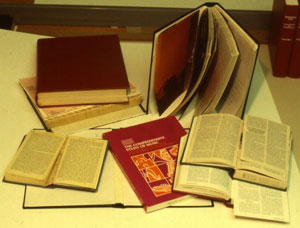What exactly are Pre-Bound Books?
 Published books arrive in a library either soft or hard cover bound. Some exceptions may be mechanical bindings such as spiral bindings. Some librarians question why pre-bound library books exist when there are hardcover books available from the publisher. A pre-bound library book is a new hardcover book that has been purchased from a publisher, in unbound signatures if possible, and then bound by a library binder rather than by a trade binder.
Published books arrive in a library either soft or hard cover bound. Some exceptions may be mechanical bindings such as spiral bindings. Some librarians question why pre-bound library books exist when there are hardcover books available from the publisher. A pre-bound library book is a new hardcover book that has been purchased from a publisher, in unbound signatures if possible, and then bound by a library binder rather than by a trade binder.
To make another distinction, you can find both pre-bound library books and pre-bound paperback books in the marketplace today. Pre-bound library books start with the pages of the hardcover edition and are bound according to the strict NISO/LBI specifications. Pre-bound paperback books start with a paperback edition from the publisher and their binding methods and materials are not governed by an industry standard.
One must only open the librarians’ web site, the “Hall of Shame,” at personalpages.tds.net/~berek/shame.html to see that trade books from many publishers do not earn any durability awards. Despite this well-trafficked web site, publishers are ignoring librarians’ complaints and only occasionally are they replacing defective titles with another binding that is no better. The problem is not new. This is why librarians and library binders got together in 1923 to draft the first specifications for library binding.
These specifications have been refined for the past 80 years and today represent a book quality that will withstand over 100 circulations in a library or school environment. However, there is a catch. Publishers and others, eager to make an extra dollar, market “library bindings” to schools and libraries. You should be aware that these are not certified bindings which meet the latest tough NISO/LBI Standard for library binding. We also call them “Reinforced Edition bindings.” Having worked many years in book manufacture, this writer helped write the specifications for library bindings. True, they are better than today’s poor quality trade edition books, but they are no match for a certified, pre-bound library book bound in accordance to the NISO/LBI Standard. To avoid disappointments with binding quality, librarians and administrators purchasing pre-bound books should make sure that the binder is certified and warranties its work. The Standard specifies methods and materials for binding volumes capable of withstanding library use, a binding that is sturdy and durable.
New books are expensive and a little bit more money spent for a far superior binding is one of the best investments. Librarians need to understand the differences between trade editions, publisher’s reinforced editions, pre-bound library editions and pre-bound paperback editions so they can buy the right book for their intended use and make the best use of the taxpayers’ money.
